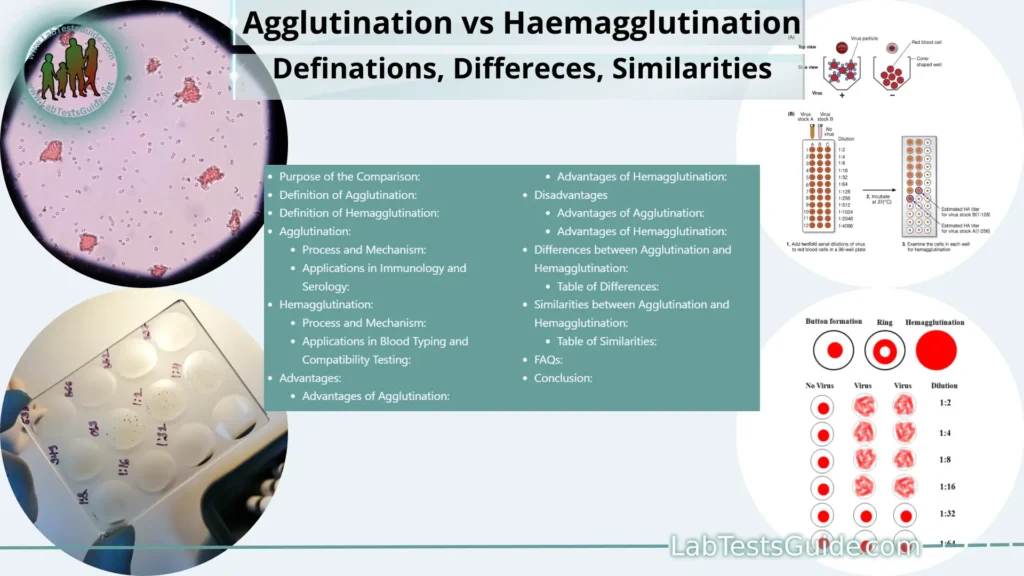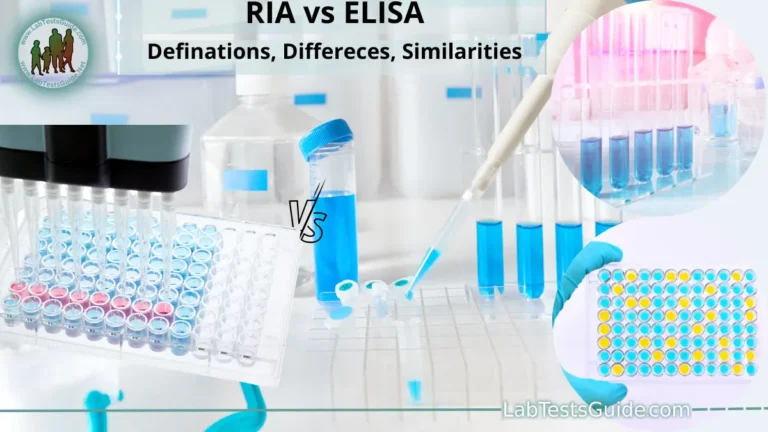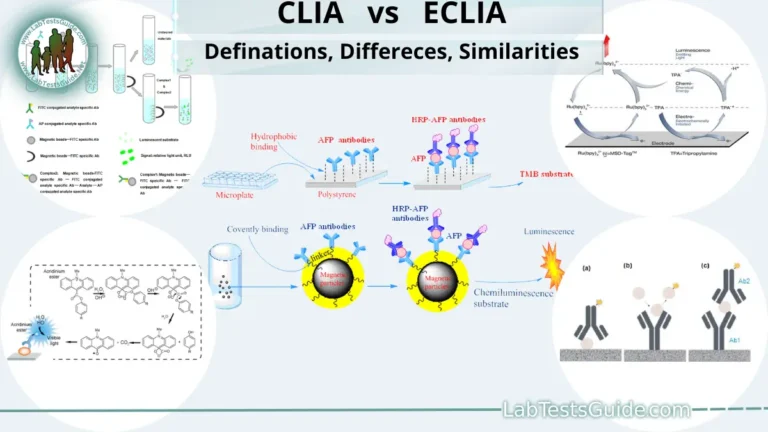Agglutination vs Haemagglutination: Agglutination and hemagglutination are both processes where particles clump together, but they differ in their specific contexts. Agglutination involves the clumping of various particles (e.g., bacteria or cells) due to specific antibodies binding to their surface antigens. On the other hand, hemagglutination is a specific type of agglutination that occurs with red blood cells when antibodies target their blood group antigens, used in blood typing and compatibility testing.

Purpose of the Comparison:
The purpose of the comparison is to enhance knowledge and provide valuable insights into these two fundamental biological phenomena, aiding researchers, healthcare professionals, and individuals interested in immunology, serology, and blood-related studies.
- Identifying the common aspects shared by agglutination and hemagglutination, such as the clumping phenomenon and their reliance on antigen-antibody interactions.
- Differentiating the types of particles involved in each process; agglutination involving various particles like bacteria or cells, while hemagglutination focusing specifically on red blood cells.
- Exploring the specific applications and diagnostic uses of agglutination in immunology and serology, as well as hemagglutination in blood typing and compatibility testing.
- Analyzing the advantages and limitations of both processes, understanding their strengths and weaknesses in different applications.
- Drawing conclusions about the importance and relevance of agglutination and hemagglutination in the medical field and their contributions to various diagnostic procedures.
Definition of Agglutination:
Agglutination is a biological process in which particles, such as bacteria, viruses, or cells, clump together when they come into contact with specific antibodies. This clumping occurs due to the binding of antibodies to surface antigens on the particles, leading to visible aggregates that can be used for various diagnostic tests in immunology and serology.
Definition of Hemagglutination:
Hemagglutination is a specific type of agglutination where red blood cells clump together in the presence of certain antibodies targeting their blood group antigens. It is utilized in blood typing and compatibility testing to determine an individual’s blood type and ensure compatibility in blood transfusions.
Agglutination:
Process and Mechanism:
Agglutination is the process in which particles, like bacteria or cells, clump together when specific antibodies bind to their surface antigens. The mechanism involves antibody-antigen interactions, where antibodies act as bridges, cross-linking multiple particles and forming visible aggregates. This process is used in various diagnostic tests for identifying infections, blood typing, and other medical applications.
Applications in Immunology and Serology:
- Blood typing: Agglutination is used to determine an individual’s blood type (A, B, AB, or O) and Rh factor (positive or negative).
- Cross-matching for blood transfusions: Agglutination tests ensure compatibility between donor and recipient blood before transfusions.
- Serological tests: Agglutination assays detect antibodies against infectious agents, aiding in the diagnosis of diseases like hepatitis, syphilis, and certain viral infections.
- Bacterial identification: Agglutination helps identify specific bacterial strains based on their surface antigens, aiding in the diagnosis of bacterial infections.
- Rapid diagnostic tests: Agglutination-based tests are utilized for quick and effective detection of certain infections in resource-limited settings.
Hemagglutination:
Process and Mechanism:
- Hemagglutination is a process where red blood cells clump together when specific antibodies target their blood group antigens.
- The mechanism involves antibody-antigen interactions, where antibodies bind to the surface antigens on red blood cells.
- Cross-linking of red blood cells occurs when antibodies attach to multiple antigens, leading to visible clumps or aggregates.
- Hemagglutination is crucial in blood typing and compatibility testing for safe blood transfusions.
Applications in Blood Typing and Compatibility Testing:
- Blood typing: Hemagglutination is used to determine an individual’s ABO blood group (A, B, AB, or O) and Rh factor (positive or negative).
- Compatibility testing: Hemagglutination assays ensure compatibility between donor and recipient blood before blood transfusions.
- Transfusion medicine: Hemagglutination is essential for matching donor blood with the recipient’s blood to prevent adverse reactions during transfusions.
- Hemolytic disease of the newborn: Hemagglutination testing is employed to detect antibodies that could cause hemolytic disease in newborns and guide appropriate medical interventions.
Advantages:
Advantages of Agglutination:
- Sensitivity: Agglutination reactions can detect small amounts of target antigens or antibodies, making them highly sensitive diagnostic tools.
- Speed: Agglutination tests provide rapid results, enabling quick diagnosis and timely medical interventions.
- Cost-effectiveness: Agglutination assays are generally cost-effective, making them accessible in various healthcare settings.
- Simplicity: Agglutination tests are relatively easy to perform, requiring minimal equipment and training.
- Versatility: Agglutination can be applied to a wide range of particles, such as bacteria, viruses, and cells, making it applicable in diverse diagnostic scenarios.
Advantages of Hemagglutination:
- Blood Typing: Hemagglutination is the primary method for determining blood types, aiding in blood transfusions and ensuring patient safety.
- High Specificity: Hemagglutination tests are highly specific in detecting blood group antigens, reducing the risk of erroneous blood typing.
- Immediate Readout: Hemagglutination reactions typically yield visible results, allowing for immediate interpretation without the need for specialized equipment.
- Wide Adoption: Hemagglutination methods are widely adopted and standardized, ensuring consistent and reliable blood typing results across different laboratories.
- Routine Use: Hemagglutination is routinely employed in blood banks, hospitals, and clinical laboratories, making it an essential part of transfusion medicine and patient care.
Disadvantages
Advantages of Agglutination:
- False Positives and False Negatives: Agglutination tests can sometimes yield false results due to cross-reactivity or interference from other substances present in the sample, leading to inaccurate diagnoses.
- Subjectivity in Interpretation: Agglutination reactions may require subjective interpretation by the operator, potentially introducing variability and reducing the reliability of results.
- Limited Quantitative Information: Agglutination tests provide qualitative results, indicating the presence or absence of antigens or antibodies but not quantifying their levels accurately.
- Complexity in Multiplexing: Performing simultaneous detection of multiple antigens or antibodies in a single agglutination test can be challenging and may require specialized techniques.
Advantages of Hemagglutination:
- Risk of Hemolysis: Hemagglutination reactions can cause hemolysis (rupture of red blood cells), potentially leading to false-positive results and clinical complications.
- Limited Sensitivity in Some Cases: Hemagglutination may not be sensitive enough to detect weakly expressed blood group antigens, leading to challenges in rare blood type identification.
- Limited in Certain Populations: Hemagglutination may be less effective in individuals who have been previously transfused or pregnant women due to the presence of naturally occurring antibodies.
- Limited Blood Supply: Hemagglutination methods can sometimes require large volumes of blood for testing, which can be problematic in situations with limited blood supply or pediatric patients.
Differences between Agglutination and Hemagglutination:
- Types of Particles Involved:
- Agglutination: Agglutination can involve a wide range of particles, including bacteria, viruses, and cells, depending on the specific antigens targeted by antibodies.
- Hemagglutination: Hemagglutination specifically involves red blood cells and their surface blood group antigens.
- Context of Use:
- Agglutination: Agglutination is used in various diagnostic tests in immunology, serology, bacterial identification, and rapid infectious disease tests.
- Hemagglutination: Hemagglutination is primarily used in blood typing and compatibility testing for blood transfusions.
- Applications:
- Agglutination: Agglutination has applications in identifying and characterizing various particles, detecting antibodies or antigens, and aiding in infectious disease diagnosis.
- Hemagglutination: Hemagglutination is essential in determining an individual’s blood type, ensuring compatibility in blood transfusions, and detecting clinically significant antibodies.
- Particle Size:
- Agglutination: Agglutination can involve particles of varying sizes, ranging from microorganisms to cells.
- Hemagglutination: Hemagglutination specifically targets relatively larger red blood cells.
- Cross-Reactivity:
- Agglutination: Agglutination tests may exhibit cross-reactivity, leading to potential false-positive results due to similarities in antigens shared by different particles.
- Hemagglutination: Hemagglutination reactions are generally more specific in targeting blood group antigens, reducing the risk of cross-reactivity.
- Mechanism in Blood Transfusions:
- Agglutination: In blood transfusions, agglutination indicates incompatibility between the donor’s and recipient’s blood types, leading to adverse reactions.
- Hemagglutination: Hemagglutination tests are used directly in blood typing and cross-matching to ensure compatibility between donor and recipient blood.
- Methodology:
- Agglutination: Agglutination tests involve mixing the sample with specific antibodies and observing visible clumping if the target antigens are present.
- Hemagglutination: Hemagglutination is observed visually when red blood cells clump together in the presence of specific antibodies.
- Significance in Hemolytic Disease:
- Agglutination: Agglutination is not directly associated with hemolytic disease of the newborn.
- Hemagglutination: Hemagglutination is related to hemolytic disease of the newborn, where maternal antibodies target fetal red blood cell antigens, causing hemolysis.
Table of Differences:
| Difference | Agglutination | Hemagglutination |
|---|---|---|
| Definition | Clumping of particles due to specific antibodies. | Clumping of red blood cells due to specific antibodies targeting blood group antigens. |
| Types of Particles Involved | Bacteria, viruses, cells, and others. | Red blood cells (erythrocytes). |
| Context of Use | Immunology, serology, bacterial identification. | Blood typing, compatibility testing, transfusions. |
| Applications | Diagnosing infections, blood typing, disease testing. | Blood typing, transfusion medicine, newborn screening. |
| Particle Size | Various sizes, microorganisms to cells. | Relatively larger cells (red blood cells). |
| Cross-Reactivity | May exhibit cross-reactivity, leading to false results. | Generally more specific, reducing cross-reactivity. |
| Mechanism in Blood Transfusions | Indicates blood type incompatibility. | Directly used for blood typing and compatibility. |
| Methodology | Mixing sample with specific antibodies, observing clumping. | Observing clumping of red blood cells with specific antibodies. |
| Significance in Hemolytic Disease | Not directly associated with hemolytic disease. | Related to hemolytic disease of the newborn. |
Similarities between Agglutination and Hemagglutination:
- Clumping Phenomenon: Both agglutination and hemagglutination result in the clumping or aggregation of particles.
- Antibody-Antigen Interactions: Both processes involve the binding of specific antibodies to corresponding antigens on the surfaces of particles or red blood cells.
- Immunological Response: Agglutination and hemagglutination are essential immune responses to foreign particles or antigens.
- Diagnostic Applications: Both reactions have significant diagnostic applications in medical and laboratory settings.
- Serological Techniques: Both are utilized as serological techniques for detecting specific antibodies or antigens in patient samples.
- Rapid Tests: Both agglutination and hemagglutination reactions provide relatively quick results, making them useful in rapid diagnostic tests.
- Blood Transfusions: Both processes are relevant to blood transfusions, ensuring blood compatibility between donors and recipients.
- Clinical Significance: Both agglutination and hemagglutination have clinical importance in determining patient blood types and detecting certain diseases.
- Specificity: Both reactions are specific in detecting particular antigens or blood group antigens.
- Importance in Immunohematology: Both processes are integral components of immunohematology, which focuses on blood group systems and blood transfusion medicine.
- Visual Observation: Both agglutination and hemagglutination reactions can be observed visually, allowing for immediate interpretation of results.
Table of Similarities:
| Similarity | Agglutination | Hemagglutination |
|---|---|---|
| Clumping Phenomenon | Both processes result in the clumping of particles or red blood cells. | Both processes lead to visible clumps or aggregates. |
| Antibody-Antigen Interactions | Specific antibodies bind to antigens on the surface of particles or red blood cells. | Specific antibodies target blood group antigens on red blood cells. |
| Immunological Response | Both processes are immune responses against foreign particles or antigens. | Both processes are part of the immune system’s defense mechanisms. |
| Diagnostic Applications | Both are used in diagnostic tests for medical and laboratory purposes. | Both have significant diagnostic applications in medical settings. |
| Serological Techniques | Both are employed as serological techniques for detecting specific antibodies or antigens. | Both are used in serological tests for various medical purposes. |
| Rapid Tests | Both reactions provide relatively quick results, facilitating rapid diagnostic tests. | Both reactions yield visible results, enabling quick assessments. |
| Blood Transfusions | Both are relevant to blood transfusions, ensuring compatibility between donors and recipients. | Both are crucial for determining blood types and safe blood transfusions. |
| Clinical Significance | Both have clinical importance in identifying blood types and detecting diseases. | Both are clinically significant in various medical contexts. |
| Specificity | Both reactions are specific in detecting particular antigens or blood group antigens. | Both reactions target specific blood group antigens with high specificity. |
| Importance in Immunohematology | Both are integral components of immunohematology, focusing on blood group systems. | Both are vital in the field of immunohematology and transfusion medicine. |
| Visual Observation | Both reactions can be visually observed, allowing for immediate result interpretation. | Both reactions are detected visually without the need for complex equipment. |
FAQs:
What is agglutination?
Answer: Agglutination is a biological process where particles clump together in the presence of specific antibodies targeting their surface antigens.
What is hemagglutination?
Answer: Hemagglutination is a specific type of agglutination where red blood cells agglutinate when specific antibodies recognize their blood group antigens.
What are the applications of agglutination in immunology and serology?
Answer: Agglutination is used in diagnostic tests to identify and characterize particles like bacteria, viruses, and cells, aiding in infectious disease diagnosis and blood typing.
How is hemagglutination employed in blood typing and compatibility testing?
Answer: Hemagglutination is crucial in determining an individual’s blood type (A, B, AB, or O) and Rh factor (positive or negative) and ensuring compatibility for blood transfusions.
Are agglutination and hemagglutination the same process?
Answer: No, agglutination and hemagglutination are similar processes involving clumping of particles, but they differ in the types of particles involved and their specific applications.
How do agglutination and hemagglutination work?
Answer: Both processes involve antibody-antigen interactions, where antibodies bind to specific antigens on particles or red blood cells, leading to clumping or aggregation.
What diagnostic tests use agglutination reactions?
Answer: Agglutination reactions are used in blood typing tests, serological tests for infectious diseases, and bacterial identification tests.
Can hemagglutination reactions lead to adverse effects in blood transfusions?
Answer: Yes, if hemagglutination reactions occur between donor and recipient blood, it can lead to adverse transfusion reactions.
Are agglutination and hemagglutination rapid tests?
Answer: Yes, both agglutination and hemagglutination reactions provide relatively quick results, making them valuable in point-of-care testing.
Are there any limitations to agglutination and hemagglutination tests?
Answer: Yes, both tests may have limitations such as false results due to cross-reactivity or interference from other substances in the sample.
How are agglutination and hemagglutination used in immunohematology?
Answer: Agglutination and hemagglutination are fundamental techniques in immunohematology, aiding in blood group testing and safe blood transfusions.
Conclusion:
In conclusion, agglutination and hemagglutination are both essential biological processes involving the clumping of particles or red blood cells due to specific antigen-antibody interactions. While agglutination is used in various diagnostic tests for identifying and characterizing particles, hemagglutination plays a vital role in blood typing and compatibility testing for safe blood transfusions. Both processes have clinical significance in immunology, serology, and transfusion medicine, contributing to medical diagnostics and patient care. Understanding the similarities and differences between these processes allows us to harness their unique applications and utilize them effectively in various medical and laboratory settings.
Possible References Used







